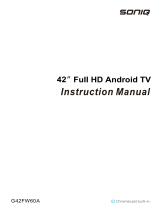
Controlling the TV
Smart Touch Control
29 Inserting the Batteries (AAA X 2)
30 Connecting to the TV
30 Reconnecting the Smart Touch Control
31 Battery Low Alarm
31 Buttons and Descriptions
33 Special Functions
Using the touchpad
34 Dragging
34 Pressing
35 Flicking
35 Pressing and Holding
35 Pressing and Dragging
36 Scrolling Up/Down
36 Scrolling Left/Right
37 Changing Channels by Entering Numbers
37 Numerical Input Guide
37 Adjusting the Touchpad
38 Show Status and Notification Banner
38 History
38 Deleting History Data
38 Searching
Virtual Remote Control
39 Changing the Virtual Remote Control Panel
39 Changing a position of the Virtual Remote Panel
39 Using the Number Panel
39 Using the Playback Control Panel
39 Using the Quick Access Panel
39 Adjusting the virtual remote panel size
Universal Remote Control Setup
40 Connecting the IR EXTENDER CABLE
41 Add the External Device
41 Using the Universal Remote Control
41 Registered External Device Management
Entering Text using the Onscreen Keypad
42 Entering Text using the QWERTY Keypad
42 Additional Features
SMART Interaction
43 Precautions
43 Face Recognition
43 TV Camera Use
44 Motion Control
44 Voice Recognition
Voice Recognition
45 Operating Environment
46 Enabling Voice Recognition
46 Voice Recognition Tutorial
46 Basic Voice Recognition Use
46 Voice Recognition Settings
46 Deactivating Voice Recognition
Motion Control
47 Operating Environment
48 Motion Control Environment Test
48 Motion Control Tutorial
48 Motion Control Activation
49 Using the Basic Motion Controls
49 Motion Control Options
50 Motion Control Screen
50 The Screen Composition while Viewing TV
51 The Smart Hub Screen Composition
Face Recognition
53 Face Registration
53 Face Recognition Login
Using Peripheral Devices
54 Keyboard Connection
54 Keyboard Use
55 Mouse Connection
55 Mouse Use
II III























